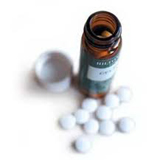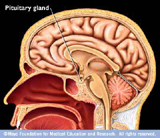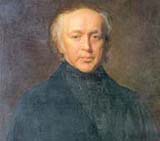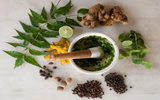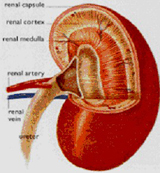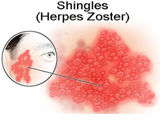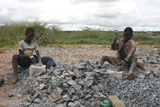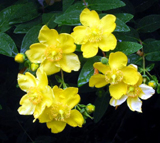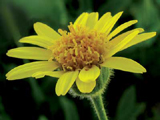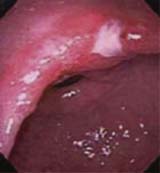Case study
A case of post-herpetic neuralgia with keloids
Post-herpetic neuralgia is a known complication of herpes zoster. The nerves in the affected dermatome of the skin send abnormal electrical signals to the brain. These signals convey a continuous burning pain and do not respond to analgesics adequately. Conventional therapy empirically proposes anti-depressants, anti-convulsants (such as gabapentin or pregabalin) and topical agents such as lidocaine patches or capsaicin lotions. There are experimental treatments, such as rhizotomy (severing or damaging the affected nerve to relieve pain) and electrical pulse therapy. Treatment is unsatisfactory but gradual recovery can occur over 2 years.Neuralgic pain can be the result of altered gene expression in sensory dorsal root ganglia (DRG) of the spinal or cranial nerves. Injury to sensory nerves induces neurochemical, physiological and anatomical modifications to afferent and central neurons. These changes contribute to increased NMDA glutamate receptor-dependent excitability of spinal dorsal horn neurons but are restricted to the affected side. A combination of these factors could contribute to the neuropathic pain of post-herpetic neuralgia.
Keloid is a hyperplastic scar tissue progressively increasing in size and invading the surrounding skin, producing bulky tumorous tissue. It is a persistent progressive growth of scar spreading beyond the site of original trauma and extending laterally into the normal skin. It occurs in the dermis and adjacent subcutaneous tissue. On microscopic examination it is a non-encapsulated mass consisting of wide and parallel bands of collagenous fibrous tissue. Conditions with multiple keloids are called keloidosis.
Etiology
The exact etiology of keloids is unknown. Predisposing factors include trauma, skin tension, infection, auto-immune phenomena, and hormonal factors. The chest and upper back are areas predisposed to keloids. These areas have a higher rate of dihydrotestosterone metabolism. The association of keloids with acromegaly, puberty, pregnancy and hyperthyroidism suggest that the pituitary may play a role. There is a familial tendency for keloid formation. In genetic studies, both autosomal recessive and autosomal dominant patterns have been reported.
Pathogenesis
Every incidence of wound repair takes place in five stages — vascular phase, inflammatory phase, re-epithelialisation, granulation and matrix and collagen remodelling or scar formation. The metabolic aberration that leads to keloid formation occurs in this later phase of scarring. In keloids the scar fails to mature.
Clinical features
A scar tissue extending beyond the original injury projecting above the surrounding skin is the hallmark of a keloid. It does not extend deep into the dermis. Keloids are devoid of hair and other adnexa. There may be parasthesia, itching, pain, cosmetic disfigurement or impaired mobility due to keloids. Complications like pitting, cracks, sinuses, ulcers, infection due to scratching and fissures may arise.
Diagnosis
Diagnosis is made on the basis of the clinical persistence and progressive growth of scar tissue for more than six months, spreading beyond the site of the original trauma. Histopathological study of keloids reveals thick collagen bundles, abundant ground substance, few fibroblasts and a few giant cells if any foreign body reactions is present. Hypertrophic scars do not extend beyond the limits of the original trauma.
Conventional management
The conventional treatments are: surgical excision, local steroid injections, pressure therapy, radiation therapy and laser therapy. Newer therapies include interferon, penicillamine and colchicines.
About homoeopathy
Homoeopathy was founded by Dr. Samuel Hahnemann of Germany at the end of the eighteenth century. While translating a book on pharmacology, he came across a statement that quinine cured malaria because it was bitter. In order to verify this hypothesis he consumed quinine while in a healthy state. To his surprise, he developed signs and symptoms simulating malaria! This prompted him to postulate that the potential of any drug substance to produce transient artificial disease is the curative property of that drug against a similar natural disease. On continuous experiments, he proved and verified this hypothesis. This natural law of healing is the fundamental principle of homoeopathy.
Philosophy of homoeopathy
The patient is considered in his totality. Every part, however tiny its structure and function may be, is intricately interconnected. The body and mind are also interconnected. This concept of totality is another basic principle of homoeopathy. Each sign and symptom is perceived with regard to its location, sensation, modality and concomitants (associated complaints). The interrelationship between various signs and symptoms is noted. The onset, evolution, intensity and sequelae of each event in the deranged health is taken into account. The patient’s physical attributes like cravings, aversions, thirst, sleep, dreams, perspiration patterns, facial expressions along with mental attributes like emotions, intellectual and memory functions are gathered. All these things in totality form the conceptual image of the sick individual.
Homoeopathic medicines are essentially experimented first on healthy human beings. The signs and symptoms, as a result of the drugs, are recorded. On taking the whole case a totality is arrived at and matched with the drug showing similar totality. The drug having most similar totality is the drug of choice. Two patients with the same diagnosis may need altogether different remedies or two patients with altogether different diagnoses may need the same remedy. Depending upon the susceptibility or sensitivity of the person, the doses and level of dilution (potency) and the mode of repetition is selected.
Fundamental cause of the disease
Like the tridoṣa concept in Āyurveda, homoeopathy also has the concept of miasms (basic disease-producing diathesis as undercurrent, known as Psora, Sycosis and Syphilis). These are basic disease-producing tendencies, partly inherited from the parents and partly acquired by the individual, making a specific combination of the three miasms, which is the fundamental cause of the disease. Those remedies matching deeply at the level of miasms are selected. Therefore homoeopathic remedies are capable of containing such disease-producing tendencies even before they flare up.
Mode of administration
Homoeopathic remedies are given in energised dilutions, known as potencies. The higher the dilution, the better is the ionisation with the release of energy. For dispensing, lactose sugar pills (vehicle) are moistened in the diluted drug and administered. This is the reason why homoeopathic medicines look alike and have the same taste. Doses of the medicine can be repeated depending upon the individual’s susceptibility and the duration of action of the remedy indi
Limitations of homoeopathic therapy
In homoeopathy, the person’s own vitality is triggered to eradicate the disease by creating an artificial transient crisis specifically needed for that totality. Hence in conditions where the vitality of the individual is too low (like in advanced cancer, renal failure), patients do not respond well. In such instances, only mere palliation is possible. Since homoeopathic medicines are studied on healthy human beings, it is not possible to experiment with the drugs on people who have developed a gross pathology in any disease, except in accidental provings like snake bite, poisoning, etc.
Homoeopathic treatment of keloids in post-herpetic neuralgia
A constitutional approach is necessary to treat the lesions because keloids are a sequelae of the complex process of a constitutional disorder inherent in the individual and not only the scar tissue. Homoeopathy treats the individual as a whole, so keloids, like any local malady, will be treated by the constitution. Evidently there cannot be one or two specific remedies for keloids. Total regression can be achieved only in keloid patients with a high susceptibility and sensitivity to homoeopathic medicines. However homoeopathy is known to have a very good scope in containing the progressive growth of the keloid. Complications like pain, itching and secondary infections leading to ulceration and sinus formation can be annihilated by effective employment of homoeopathy.
Here is a sample case of post-herpetic neuralgia and keloids. The illness had made life miserable for the patient. Even though hailing from a very poor family background, this person had not left any stone unturned in his treatment of post-herpetic neuralgia and keloids. He was referred to us by a plastic surgeon of a government medical college for treatment. His poverty had increased as he had been unemployed for years due to neuralgic pains. He could not afford to buy medication as the quantum and cost of medication he was required to consume was enormous. He was time and again counselled by earlier physicians that he would have to live with both the ailments — keloids and post-herpetic neuralgia — as they would not be cured for the rest of his life.
The case
Mr. D., a male aged 34, was referred to us by the Department of Plastic surgery, JIPMER (an autonomous medical college). He hailed from a remote village 85 kilometers away in the district of Villupuram in Tamil Nadu, India. His usual occupation was cutting stones into various shapes for construction purposes, involving much physical labour with a hammer and chisel.
Six years ago, he woke up with blister-like eruptions on his right pectoral region, arm and shoulder followed by severe pain, subsequently diagnosed and treated by local physicians as herpes zoster. The herpes zoster lesions got completely healed within one month giving rise to scar tissue. The scars of the herpes zoster eruptions started progressively developing into keloids. The neuralgic pains (post-herpetic neuralgia) continued, making his life miserable. He couldn’t pursue his job due to pain and extreme exhaustion.
The keloid lesions were progressively growing in size. At times, it was difficult for physicians to decide whether the pain was purely due to the keloids or because of post- herpetic neuralgia. However the modalities, the direction and radiation of pain, clearly indicated that he had severe pain of post-herpetic neuralgia. He was passing through many sleepless nights due to this pain and was getting completely prostrated and fatigued. He also had recurring pain in the right shoulder, starting from the neck or pectoral region and could not take the least exertion. He had become very restless and was seriously thinking about death.
Besides the post-herpetic lesions, he also had keloids at several other places. He developed keloids in the left arm from the wounds caused by the sharp stone splinters over the last 10 years. He had keloids in the right leg caused by a trivial burn injury at the age of 10. He also had a small keloid lesion on his right wrist.
Besides the above complaints, he had herpes simplex on glans penis recurring over the last two years, causing burning along the urethra after urination.
His appetite was good, he craved meat and spicy food but got a bloated or distended feeling in the abdomen within five minutes of eating. He also had a stiff neck from carrying weights on his head.
His thirst was excessive and he perspired a lot all over the body which he did not mind. His urine was yellow. His bowels were clear. Before the herpes zoster, he had sound sleep lying in the knee-chest position or on his sides. He salivated more than the average person, especially during his sleep and had fearful dreams of ghosts.
He had incidences of abdominal pains in childhood which were vague. They were not diagnosed but empirically treated. He had typhoid six years ago for about two weeks.
His family history showed that his father was in the same profession (cutting stones) and was a chronic alcoholic. His mother was healthy. The parents had a consanguineous marriage. The patient was the third of five children, three boys and two girls. He was restless as a child. His brother too was in the same profession and he had headaches, some ophthalmic problem and a vague backache. One of his sisters was mentally handicapped. The patient was married at the age of 27. He also had a consanguineous marriage (this is very common in southern India). His wife is healthy with occasional leucorrhoea and dysmenorrhea.
He liked company but tended to get angry and even violent if provoked. He considered himself quite bold. He was fed up with suffering and thought calmly about his death.
Case analysis
Taking all the above data into consideration,
the case was analysed on homoeopathic principles and a portrait (conceptual image) of the case was formed. The absence of fever in this case indicated that immunity or sector vitality was lacking in this individual. The herpes zoster, creating a nerve damage, indicates a syphilitic miasm (one of the three bases for disease-producing tendencies — degeneration). All his complaints were aggravated at night. Moreover, the very tendency to keloid formation indicates uncontrolled actions of the system, especially in the fifth and final phase of healing.
Treatment
10.02.2001: Zincum met 200 on was given, followed by Ranunculus bulb 30 SOS for pain. Zincum met is a recognised remedy for suppressed eruptive fevers like chicken pox, measles or shingles. Ranunculus bulb is a remedy known for its efficacy in neuralgic pains especially post-herpetic neuralgia.
14.02.2001: Herpes simplex (herpes genitalia) surfaced: burning, tiny eruptions around the glans penis. Saliva started dribbling out. Mezereum 30 for a day followed by Merc. sol 30 tds for three days. Surfacing of herpes simplex is to be taken as a favourable sign in the process of cure. Mezereum is a very good remedy for herpes simplex in the acute form. Merc sol was obviously indicated as a chronic remedy following well after Mezereum and was indicated by the excessive dribbling of saliva and night aggravations.
18.02.2001: Herpes simplex slightly better — Pulsatilla 30 tds for three days.
31.03.2001: Syphilinum 1M single was given with Ranunculus bulb 30 SOS.
12.4.2001: His neuralgic pains were slightly relieved but the exhausted feeling continued. The size of the keloids was the same. Arsenicum album 30 tds was given for two days. Arsenicum album is a known remedy for profound prostration and post-herpetic neuralgia.
25.4.2001: Severe deep-seated bodyaches, emerged making life miserable. Tuberculinum 1M single dose was given followed by Radium brom 30 tds. The nosode Tuberculinum was needed in order to facilitate the action of indicated remedies like Ranunculus bulb.
20.5.2001: He felt better in general. There was a slight itching in the lesions towards the evening. The summer heat was unusually intolerable at this time. The symptoms had a morning aggravation to the extent that he couldn’t work. He perspired easily. He was disturbed this month because of a division in the family due to a dispute. His elder brother had ridiculed him. Sulph 200 was given as a single dose. This remedy is known to be the best anti-psoric remedy, which clears the background for the action of indicated remedies.
14.07.2001: Now the pains were only very occasional. The itching was also much less. The energy levels had improved. He had resumed his stone cutting job slowly. Ran bulb 30 SOS.
07.09.2001: Pain in the lesions was now relieved. Itching was also relieved. Size of the keloid lesions remained static. Thiosinaminum 30 od was prescribed for two weeks. Thiosinaminum is the remedy known to induce absorption of undue scars in the body.
01.10. 2001: He had been getting pain along the lesions off and on, though the frequency of the pain is much less. He was still restless. Zincum met 200 was given as a single dose with Arsenicum album 6C tds for five days and Valeriana 200 SOS for pain. Valeriana is a recognised remedy for increasing the pain threshold of an individual.
10.12.2001: The keloid lesions had started showing regression especially on the pectoral and sternal region. Post-herpetic neuralgia was status quo in severity as well as frequency. Ranunculus bulb 30tds was given for one month, Thuja occi Q and Hypericum Q was given for topical application in pure ghee from cow’s milk. Thuja is a known remedy for reversing any extra tumour-like growth on the skin and Hypericum is a recognised agent for affections of the nerves.
17.01.2002: His neuralgic pains were the same. Pain in neck and upper limbs was the same. Relief in headaches. Herpes in the genitalia did not recur for two months. Zincum met 1M was given as a single dose along with Ranunculus bulb 30 tds.
15.03.2002: His neuralgic pains had decreased in severity as well as frequency. He still got occasional itching. Now the disease had become tolerable. He had developed wrist pain due to hammering with his right arm in the course of his work. Ranunculus bulb 30 tds along with Thuja occi Q and Hypericum Q for topical application continued.
01.6.2002: His bodyaches and joint pains were better. The keloid pains (post-herpetic neuralgia as well as pricking in lesions) were much improved. Itching in the keloids was also less. Ranunculus bulb 30 tds along with Thuja occi Q and Hypericum Q for topical application continued.
18.8.2002: The keloid lesions had regressed. The joint pains and deep muscular pains had reactivated. He had severe episodes of neuralgic pains and cramps in the muscles during the night. Zincum met 1M along with Valeriana 30 tds and Thuja occi Q and Hypericum Q for topical application were given.
11.11.2002: His keloid lesions had further regressed. The itching was much relieved. His neuralgic pains still showed up from time to time. Ranunculus bulb 30 tds.
15.03.2003: He had taken some herbal medicine for abdominal pain which had reactivated his complaints. Valeriana 200 was given as a single dose followed by .Mezereum 30 tds for five days, followed by Ranunculus bulb 30.
09.04.2003: The size of the keloids had further regressed. He had severe neuralgic pains and a prostrated feeling. Ars alb 1M single dose was given along with Ranunculus bulb 30 tds for one month.
23.08.2004: He was doing pretty well. He was working 7 hours a day. He had met with an accident leading to fracture of his right tibia fibula three months back. He was in plaster and had to take conventional medicines in the form of antibiotics and painkillers. Complaints of deep-seated bodyaches and neuralgia recurred. .Arnica 200 single dose followed by Rhus tox 30 tds for three days followed by Ruta Gr 30 tds for ten days were given. Arnica is a remedy for ill-effects from blunt injuries and Rhus tox, Ruta are known remedies for sprains in the muscles, tendons and ligaments.
14.02.2005: His post-herpetic neuralgia had surfaced on February 8 for no reason. Coincidentally, that day was Amavasya (No moon day). He had fetor oris, hot urine and a desire for cool fresh open air. His thirst had relatively decreased. He was given Pulsatilla 30 QID for 3 days followed by Silicea 30 QID for 3 days again followed by Acid flour 30 QID for 3 days.
31.03.2005: He came with a burning pain in the epigastrium, retrosternal burning with eructations of sour fluid, gas, slight coughing after meals, burning urine. His keloids had almost completely regressed. Tuberculinum 1M single dose followed by Phosphorus 200 single dose to be repeated after 10 days were given. Tuberculinum and Phosphorus are recognised remedies for hypersensitive subjects with acid peptic disorders.
Conclusion
The photographs on this page clearly show us how the keloid mass had regressed with homoeopathic treatment. The response of the case to keloid treatment has proven the efficacy of homoeopathic treatment. There is no record in the world where keloid lesions have regressed completely. Here, this holistic treatment even eradicated the keloid-forming tendency. The scars formed after the accident were observed for two years and did not develop keloids. The earlier keloid lesions in the area of herpes zoster have regressed completely.
This case clearly indicates that seemingly local maladies like keloids can be treated as integral components of the whole being. Once you treat the person in his totality all local complaints reverse. We can definitely undertake treatment of local maladies like keloids with homoeopathy on a mass-scale. However there cannot be any specific remedy for the affliction. Each case requires an individualised remedy, indicated on the basis of the totality of symptoms. One has to go on employing a series of homoeopathic remedies as the indications go on surfacing. We are indebted to the patient, as he had full faith in us and followed the treatment regularly till the response was substantial.
Before treatment (10.02.2001):


After treatment (22.08.2004):


Dr. Uttareshwar Pachegaonkar (M.D. Homoeopathy) is the Director of the Homoeopathic Clinic and Research Centre at SAIIIHR.
Dr. Arati Sharma (M.D. Homoeopathy) is the Addl.Director of the Homoeopathic Clinic and Research Centre at SAIIIHR.
Share with us (Comments,contributions,opinions)
When reproducing this feature, please credit NAMAH,and give the byline. Please send us cuttings.
